HinduOfUniverse
Hindu Goddesses
As per the Hindu religion, the Supreme Being contains both masculine and
feminine traits. The female part is as important as the male part. One has to
consider the feminine aspect of the divine, in order to know the ultimate truth.
It is believed that all goddesses of the Hindu pantheon are special forms of the
divine mother- Shakti. To recognize the feminine aspect, it is necessary to
restore wholeness, completeness and universality.
There are many goddesses and local deities in the Hindu mythology. Here we will
discuss some of the popular Hindu goddesses (forms of Shakti).
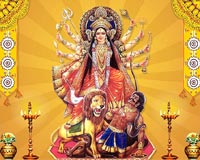 Goddess
Durga (Mother) Goddess
Durga (Mother)
Durga symbolizes the power of the Supreme Being that maintains moral order and
righteousness in the universe. Worship of the goddess Shakti is very popular
among the Hindu people. Durga stands for the unified symbol of all divine forces
(Shaktis).
Goddess Lakshmi
Lakshmi is the auspicious goddess of wealth and fortune, whether it is material
or spiritual. The word ''Lakshmi'' has been derived from the Sanskrit word
Lakshay, meaning "aim" or ''goal''. Goddess Lakshmi suggests the aim of life,
which includes all worldly and spiritual success.
Goddess Saraswati
Saraswati Devi is the Goddess of arts, music, knowledge, and wisdom. Saraswati
is considered as the divine consort of Lord Brahma, the Creator of the universe
in the Hindu Religion.
Goddess Kali
Kali is one of the many forms of Shakti. Maha Kaali is the fiercest of all
goddesses of Hinduism. The word Kali has its roots in the Sanskrit word "Kaal"
which means time. And nothing escapes from time. Goddess Kali is sometimes
referred as the goddess of death.
Goddess Parvati
Parvati is a well known goddess in the Hindu mythology. Goddess Parvati is the
divine consort of Lord Shiva, the trinity god. Parvati is also considered as a
representation of Shakti or Durga, but the gentle aspect of that goddess not the
fierce one.
Ganga
The River Goddess Ganga / Ganges is considered as the most sacred river of the
Hindu Mythology. River Ganges is very much popular in India and is worshipped as
a goddess. Ganga is the most revered river in the world.
Radha
Goddess Radha is a well-known personality in Hindu Mythology. She is also known
as Srimati Radharani in the northern part of India. Radha is usually depicted
with her paramour Krishna.
Sita
Sita is the consort of Lord Rama, the seventh avatar (incarnation) of Lord
Vishnu. Sita is the one of the most popular goddesses of Indian History. Devi
Sita is regarded as the incarnation of Goddess Lakshmi, the divine consort of
Lord Vishnu.
Durga
|
Characteristics : |
Strength, Morality, Power, Protector |
|
Other Names : |
Jagdamba, Shakti, Bhagwati, Devi, Maa |
|
Weapon : |
Trident, Chakra, Snake, Conch shell, Mace, Bow, Long sword, Thunderbolt
|
|
Abode : |
Trikoota Mountain |
|
Vehicle (Vahana) : |
Lion |
|
Mula Mantra : |
Om Sri Durgaya Namah |
|
Durga Gayatri Mantra: |
Aum Girijaye Cha Vidmahe
Shiva Priyaye Cha Dheemahi
Tanno Durga Prachodayat |
Durga
Maa (Mother) Durga symbolizes the power of the Supreme Being that maintains
moral order and righteousness in the universe. Worship of the goddess Shakti is
very popular among the Hindus. Durga stands for the unified symbol of all divine
forces (Shaktis). Goddess Durga is the divine mother, who protects people from
evil forces of selfishness, jealousy, hatred, anger and ego. Mother's love and
her kindness towards her child, is the best example of pure love in this whole
universe.
Likewise, the love of Maa Bhagwati (Durga) towards her devotee (Child) is pure
and serene. Maa (Mother) never asks for a favour from her child. She pours her
kindness and warmth on the child without desiring anything in return. The love
of Jagdamba is like a free flowing river. Durga loves her each and every devotee
(Child) without any discrimination.
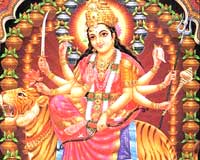 Origin
of Goddess Origin
of Goddess
Durga It is believed that once the existence of the universe was under a threat
by Mahishasura (the demon). The Gods pleaded Shiva to protect their world from
the evil forces. Lord Shiva asked the three goddesses, Saraswati, Maa Kali and
Maa Lakshami to release their powers (shaktis). The Power emerged in a female
form. The Divine light emerged and a goddess of exceptional power appeared with
many arms. She was beautiful as well as ferocious.
Durga was an extremely gorgeous girl with full of rage. The gods named her Durga,
the invincible one and they furnished her with all their arms. Durga rode on a
lion to the top of a mountain. In a violent battle, she killed Mahishasura and
thus, saved the world from the demon's threat.
Durga - The Image
The word Durga has been derived from Sanskrit language which means a fort or a
place that is difficult to reach. In the Images, Shakti is visible in the female
form, wearing red clothes. Goddess has eighteen arms, carrying many items in her
hands. The red color symbolizes fierceness and it suggests that goddess destroys
evil and protects people from pain and misery caused by evil forces. Durga
riding a tiger shows that she holds infinite power and uses it to save virtue
and destroy evil. The eighteen arms holding weapons signify the unattainable
energy that Maa Durga possesses. Different weapons suggest the idea that she can
face any evil force without consideration.
Durga Chalisa
Shri Durga Chalisa is a "forty verse" prayer. These verses are usually recited
or chanted by groups. The acts and deeds of Sri Durga are recalled in these
verses to aid the devotee to meditate on virtuous and noble qualities.
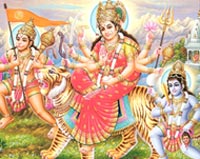
Namo Namo Durge Sukh Karani, Namo Namo Ambe Dukh Harani
Nirakar Hai Jyoti Tumhari, Tihoun Lok Phaili Uujiyaari
Shashi Lalaat Mukh Maha Vishala, Netra Lal Bhrikoutee Vikaraala
Roop Maatu Ko Adhik Suhaave, Darshan Karata Jana Ati Sukh Paave
Tum Sansar Shakti Laya Keena, Palana Hetu Anna Dhan Deena
Annapoorna Hui Tu Jag Pala, Tumhi Aadi Sundari Bala
Pralayakala Sab Nashana Haari, Tum Gouri Shiv Shankar Pyari
Shiv Yogi Tumhre Gun Gaavein, Brahma Vishnu Tumhein Nit Dhyavein
Roop Saraswati Ka Tum Dhara, Day Subuddhi Rishi Munina Ubara
Dharyo Roop Narsimha Ko Amba, Pragat Bhayi Phaad Ke Khamba
Raksha Kari Prahlad Bachaayo, Hiranyaykush Ko Swarga Pathayo
Lakshmi Roop Dharo Jag Maahin, Shree Narayan Anga Samahin
Ksheer Sindhu Mein Karat Vilaasa, Daya Sindhu Deejey Man Aasa
Hingalaja Mein Tumhi Bhavani, Mahima Amit Na Jaat Bakhani
Matangi Aru Dhoomawati Mata, Bhuvaneshwari Bagala Sukhdata
Shree Bhairav Tara Jag Tarani, Chhinna Bhala Bhava Dukh Nivarini
Kehari Vahan Soha Bhavani, Laangur Veer Chalata Agavani
Kar Mein Khappar Khadaga Virajay, Jako Dekh Kaal Dar Bhajey
Sohe Astra Aur Trishula, Jase Uthata Shatru Hiya Shoola
Nagarkot Mein Toumhi Virajat, Tihoun Lok Mein Danka Baajat
Nagarkot Mein Toumhi Virajat, Tihoun Lok Mein Danka Baajat Shumbh
Nishumbh Daanuv Tum Maare, Rakta Beej Shankhana Sanghaare
Mahishasur Nrip Ati Abhimaani, Jehi Agh Bhar Mahi Akulaani
Roop Karaal Kali ka Dhara, Sen Sahita Tum Tihin Samhara
Pari Gaarh Santana Par Jab Jab, Bhayi Sahay Matou Tum Tab Tab
Amarpuri Arubaa Sab Lokaa, Tab Mahima Sab Kahey Ashoka
Jwala Mein Hai Jyoti Tumhari, Tumhein Sada Poojey Nar Nari
Prem Bhakti Se Jo Yash Gave, Dukh Daridra Nikat Nahin Aave
Dhyaave Tumhein Jo Nar Man Layi, Janma Maran Tako Chhouti Jaayi
Yogi Sur Muni Kahat Pukaari, Yog Na Hoye Bina Shakti Tumhari
Shankara Acharaj Tap Ati Keenho, Kaam Krodh Jeet Sab Leenho
Nishidin Dhyan Dharo Shankar Ko, Kaahu Kaal Nahin Soumiro Tumko
Shakti Roop Ko Maram Na Payo, Shakti Gayi Tab Man Pachitayo
Sharnagat Huyi Kirti Bakhaani, Jai Jai Jai Jagadambe Bhavani
Bhayi Prasanna Aadi Jagadamba, Dayi Shakti Nahin Keen Vilamba
Maukon Maatu Kashta Ati Ghero, Tum Bin Kaun Harey Dukh Mero
Asha Trishna Nipat Satavein, Ripu Moorakh Mohe Ati Darpaave
Shatru Nash Kijey Maharani, Soumiron Ikchit Tumhein Bhavani
Karo Kripa Hey Maatu Dayala, Riddhi Siddhi Dey Karahou Nihaala
Jab Lagi Jiyoun Daya Phal Paoun, Tumhro Yash Mein Sada Sounaoun
Durga Chalisa Jo Nar Gaavey, Sab Sukh Bhog Parampad Pavey
Devidas Sharan Nij Jaani, Karahoun Kripa Jagadambe Bhavani
Different Names of Durga
Goddess Durga is the embodiment of the divine force of the Almighty. The word
Durga, in Sanskrit means "the invincible". Durga Devi represents power,
strength, morality and protection. Maa Durga is the destroyer of sin and
protector of morality. Goddess Durga is also known as Shakti (Power). Durga
came into being, when Maha lakshmi, Maha Saraswati and Maha Kali assimilated
their powers. So, Durga is the ultimate power. Durga is the mother, as well as
the slayer of evils at the same time. Goddess Durga is known by 108 different
names. It is believed that Maa Durga gets happy if, these names are spoken
with a dedicated heart. So, recite these names of Durga and make her happy.
|
Names |
Meanings |
|
Sati |
One who got burned alive |
|
Saadhvi |
The Sanguine |
|
Bhavaprita |
One who is loved by the universe |
|
Bhavaani |
The abode of the universe |
|
Bhavamochani |
The absolver of the universe |
|
Aarya |
Goddess |
|
Durga |
The Invincible |
|
Jaya |
The Victorious |
|
Aadya |
The Initial reality |
|
Trinetra |
One who has three-eyes |
|
Shooldharini |
One who holds a monodent |
|
Pinaakadharini |
One who holds the trident of Shiva |
|
Chitra |
The Picturesque |
|
Chandaghanta |
One who has mighty bells |
|
Mahatapa |
With severe penance |
|
Manah |
Mind |
|
Buddhi |
Intelligence |
|
Ahankaara |
One with Pride |
|
Chittarupa |
One who is in thought-state |
|
Chita |
Death-bed |
|
Chiti |
The thinking mind |
|
Sarvamantramayi |
One who possess all the instruments of thought |
|
Satta |
One who is above all |
|
Satyanandasvarupini |
Form of Eternal bliss |
|
Ananta |
One who is Infinite or beyond measure |
|
Bhaavini |
The Beautiful Woman |
|
Bhaavya |
Represents Future |
|
Bhavya |
With Magnificence |
|
Abhavya |
Improper or fear-causing |
|
Sadagati |
Always in motion, bestowing Moksha (salvation) |
|
Shaambhavi |
Consort of Shambhu |
|
Devamata |
Mother Goddess |
|
Chinta |
Tension |
|
Ratnapriya |
Adorned or loved by jewels |
|
Sarvavidya |
Knowledgeable |
|
Dakshakanya |
Daughter of Daksha |
|
Dakshayaj˝avinaashini |
Interrupter of the sacrifice of Daksha |
|
Aparna |
One who doesnt eat even leaves while fasting |
|
Anekavarna |
One who has many complexions |
|
Paatala |
Red in color |
|
Paatalavati |
Wearing red-color attire |
|
Pattaambaraparidhaana |
Wearing a dress made of leather |
|
Kalamanjiiraranjini |
Wearing a musical anklet |
|
Ameyaa |
One who is beyond measure |
|
Vikrama |
Violent |
|
Krrooraa |
Brutal (on demons) |
|
Sundari |
The Gorgeous |
|
Sursundari |
Extremely Beautiful |
|
Vandurga |
Goddess of forests |
|
Maatangi |
Goddess of Matanga |
|
Matangamunipujita |
Worshipped by Sage Matanga |
|
Braahmi |
Power of God Brahma |
|
Maaheshvari |
Power of Lord Mahesha (Shiva) |
|
Aeindri |
Power of God Indra |
|
Kaumaari |
The adolescent |
|
Vaishnavi |
The invincible |
|
Chaamunda |
Slayer of Chanda and Munda(demons) |
|
Vaarahi |
One who rides on Varaah |
|
Lakshmi |
Goddess of Wealth |
|
Purushaakriti |
One who takes the form of a man |
|
Vimalauttkarshini |
One who provides joy |
|
Gyaana |
Full of Knowledge |
|
Kriya |
One who is in action |
|
Nitya |
The eternal one |
|
Buddhida |
The bestower of wisdom |
|
Bahula |
One who is in various forms |
|
Bahulaprema |
One who is loved by all |
|
Sarvavahanavahana |
One who rides all vehicles |
|
NishumbhaShumbhaHanani |
Slayer of the demon-brothers Shumbha Nishumbha |
|
MahishasuraMardini |
Slayer of the bull-demon Mahishaasura |
|
MadhuKaitabhaHantri |
Slayer of the demon-duo Madhu and Kaitabha |
|
ChandaMundaVinashini |
Destroyer of the ferocious asuras Chanda and Munda |
|
Sarvasuravinasha |
Destroyer of all demons |
|
Sarvadaanavaghaatini |
Possessing the power to kill all the demons |
|
Sarvashaastramayi |
One who is deft in all theories |
|
Satya |
The truth |
|
Sarvaastradhaarini |
Possessor of all the missile weapons |
|
Anekashastrahasta |
Possessor of many hand weapons |
|
AnekastraDhaarini |
Possessor of many missile weapons |
|
Komaari |
The beautiful adolescent |
|
Ekakanya |
The girl child |
|
Kaishori |
The adolescent |
|
Yuvati |
The Woman |
|
Yati |
Ascetic, one who renounces the world |
|
Apraudha |
One who never gets old |
|
Praudha |
One who is old |
|
Vriddhamaata |
The old mother (loosely) |
|
Balaprada |
The bestower of strength |
|
Mahodari |
One who has huge belly which stores the universe |
|
Muktakesha |
One who has open tresses |
|
Ghorarupa |
Having a fierce outlook |
|
Mahaabala |
Having immense strength |
|
Agnijwaala |
One who is poignant like fire |
|
Raudramukhi |
One who has a fierce face like destroyer Rudra |
|
Kaalaratri |
Goddess who is black like night |
|
Tapasvini |
one who is engaged in penance |
|
Narayani |
The destructive aspect of Lord Narayana (Brahma) |
|
Bhadrakaali |
Fierce form of Kali |
|
Vishnumaya |
Spell of Lord Vishnu |
|
Jalodari |
Abode of the ethereal universe |
|
Shivadooti |
Ambassador of Lord Shiva |
|
Karaali |
The Violent |
|
Ananta |
The Infinite |
|
Parameshvari |
The Ultimate Goddess |
|
Katyayani |
One who is worshipped by sage Katyanan |
|
Savitri |
Daughter of the Sun God Savitr |
|
Pratyaksha |
One who is real |
|
Brahmavaadini |
One who is present everywhere |
Lakshmi
|
Characteristics : |
Wealth, Fortune, Courage and Fertility |
|
Other Names : |
Padma, Bhargavi, Sridevi, Aiswarya |
|
Famous Prayers : |
Sri Lakshmi Stuti, Sri Sukta, Agasti Lakshmi Strota |
|
Consort : |
Lord Vishnu |
|
Vehicle (Vahana) : |
Owl (Ulooka) |
|
Mula Mantra : |
Om Sri Maha Lakshmyai Namah |
Goddess Lakshmi
Lakshmi is the auspicious goddess of wealth and fortune, whether it is material
or spiritual. The word ''Lakshmi'' has been derived from the Sanskrit word
Lakshay, meaning "aim" or ''goal''. Goddess Lakshmi suggests the aim of life,
which includes all worldly and spiritual success. Lakshmi is the divine consort
of Lord Vishnu and provides him with wealth for the maintenance and preservation
of the creation. Sometimes, Maha Lakshmi is also known as ''Laxmi''.
Lakshmi is the goddess of wealth, luxury, fertility, fortune, purity, beauty,
power, generosity and auspiciousness. She is claimed to fulfill the promises of
material, wealth and contentment.
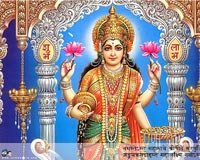 Lakshmi
and her association with "Shri'' Lakshmi
and her association with "Shri''
According to the Hindu mythology, the sacred name of Lakshmi is ''Shri''.
Whether in written or verbal form, ''Shri'' always suggests presence of goddess
Lakshmi in it. ''Shri'' is written at the top of most of the documents. It is
usually spoken before addressing a god, or any revered individual. The usage of
''Shri'' itself evokes grace, affluence, abundance, authority and
auspiciousness. The word ''Shri'' is spoken or written, an aura of holiness is
established. Sri is associated with the material side of life, just like the
word ''Om'' is associated with the spiritual side of life.
Goddess Lakshmi - The Image
Generally, Lakshmi is portrayed as a beautiful lady with golden complexion,
dressed in red color attire and adorned with precious jewels. Lakshmi has four
hands representing the four ends of human life, Kama (desires), Artha (wealth),
and Moksha (liberation) from the cycle of birth and death. She holds lotus bud
in two of her hands, which stands for beauty, purity, spirituality and
fertility. She sits on a fully blossomed lotus, a seat of divine truth.
Cascades of gold coins are seen flowing from her hands, illustrating that she
blesses people with wealth. The constant effort of two elephants is often shown
standing next to the goddess and spraying water. It denotes that, in accordance
with one's dharma when governed by wisdom and purity, leads to both material and
spiritual prosperity. The personal charm of Lakshmi is considered par
excellence. An aura of divine happiness, mental and spiritual satisfaction, and
prosperity always exists around her.
Belief Regarding Goddess Lakshmi
It is believed that Lakshmi resides in a place where virtue, righteous- ness,
truth and compassion prevail. Goddess Lakshmi is considered to stay at a clean
place. Wealth is required to meet the basic needs of life. People worship
Lakshmi for the well being and prosperity of the family.
On the auspicious night of Diwali, Hindus worship Lakshmi ceremonially at home,
pray for her blessings. It is believed that on this night the goddess herself
visits the homes and replenishes the inhabitants with wealth.
Lakshmi Chalisa
Lakshmi Chalisa is a forty verse prayer dedicated to Maha Lakshmi, the goddess
of wealth and prosperity. Shri Laxmi Chalisa is believed to have been composed
by Sundardasa. Verses are usually dedicated to praise the goddess. The acts
and deeds of Goddess Lakshmi are recalled in these verses to aid the devotee
to meditate on virtuous and noble qualities.
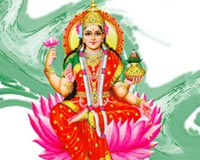
II Doha II
Maatu Lakshmi Kari Kripaa, Karahu Hriday Mein Vaas I
Manokaamanaa Siddh Kari, Puravahu Jan kii Aas I I
II Chauratha II
Sindhusutaa Main Sumiron Tohii, Jnaan Buddhi Vidyaa Dehu Mohii I
Tum Samaan Nahiin Kou Upakaarii, Sab Vidhi Prabhu Aas Hamaarii II
II Chaupaai II
Jai Jai Jagat Janani Jagadambaa, Sab Kii Tumahii Ho Avalambaa
Tumahii Ho Ghat Ghat Kii Vaasii, Bintii Yahii Hamarii Khaasii
Jagajananii Jay Sindhu Kumaarii, Diinan Kii Tum Ho Hitakaarii
Binavon Nitya Tumhe Mahaaraanii, Krapa Karo Jag Janani Bhavaanii
Kehi Vidhi Astuti Karon Tihaarii, Sudhi Lijain Aparaadh Bisaarin
Krapaadrasti Chitabahu Mam Orii, Jagat Janani Binatii Sunu Morii
Jnaan Buddhi Jay Sukh Kii Daataa, Sankat Harahu Hamaare Maataa
Kshiir Sindhu Jab Vishnumathaayo, Chaudah Ratn Sindhu Upajaayo
Tin Ratnan Manh Tum Sukhraasii, Sevaa Kiinh Banin Prabhudasi
Jab Jab Janam Jahaan Prabhu Liinhaa, Ruup Badal Tahan Sevaa Kiinhaa
Svayam Vishnu Jab Nar Tanu Dhaaraa, Liinheu Avadhapurii Avataaraa
Tab Tum Prakati Janakapur Manhin, Sevaa Kiinh Hraday Pulakaahii
Apanaavaa Tohi Antarayaamii, Vishvavidit Tribhuvan Ke Svaamii
Tum Samaprabal Shakti Nahi Aanii, Kahan Lagi Mahimaa Kahaun Bakhaanii
Man Kram Bachan Karai Sevakaaii, Manuvaanchhint Phal Sahajay Paaii
Taji Chhal Kapat Aur Chaturaai, Puujahi Vividh Bhaanti Man Lai
Aur Haal Main Kahahun Bujhaaii, Jo Yah Paath Karai Man Laaii
Taakahan Kouu Kast Na Hoii, Manavaanchhit Phal Paavay Soii
Traahimahi Jay Duhkh Nivaarini, Vividh Tap Bhav Bandhan HaariniZ
Jo Yah Parhen Aur Parhaavay, Dhyan Lagavay Sunay Sunavay
Taakon Kou Na Rog Sataavay, Putr Aadi Dhan Sampati Paavay
Putrahiin Dhan Sampati Hiinaa, Andh Vadhir Korhii Ati Diinaa
Vipr Bulaaii Ken Paath Karaavay, Shaankaa Man Mahan Tanik Na Laavay
Path Karaavay Din Chalisa, Taapar Krapaa Karahin Jagadiishaa
Sukh Sampatti Bahut Sii Paavay, Kamii Nanhin Kaahuu Kii Aavay
Baarah Maash Karen Jo Puujaa, Ta Sam Dhani Aur Nahin Duujaa
Pratidin Paath Karehi Man Manhii, Taasam Jagat Katahun Kou Naahiin
Bahuvidhi Kaa Men Karahun Baraaii, Lehu Pariikshaa Dhyaan Lagaaii
Kari Vishvaas Karay Brat Nemaa, Hoi Siddh Upajay Ati Prema
Jay Jay Jay Lakshmi Mahaaraanii, Sab Mahan Vyaapak Tum Gunkhaanii
Tumhro Tej Praval Jag Maannhin, Tum Sam Kou Dayaalu Kahun Naahiin
Mo Anaath Kii Sudhi Ab Lijay, Sannkat Kaati Bhakti Bar Dijay
Bhuulchuuk Karu Chhimaa Hamaarii, Darasan Dijay Dasaa Nihaarii
Binu Darasan Byaakul Ati Bhaarii, Tumhinn Akshat Paavat Dukh Bhaarii
Nahinn Mohi Jnaan Buddhi Hai Tan Mann, Sab Jaanat Tum Apane Man Men
Roop Chaturbhuj Kari Nij Dhaaran, Kasht Mor Ab Karahu Nivaaran
Kehi Prakaar Mein Karahun Baraaii, Jnaan Buddhi Mohin Nahin Adhikaaii
Uthi Kainn Praatakaray Asanaanaa, Jo Kachu Banay Karay So Daanaa
Ashtami Ko Brat Karay Ju Praanii, Harashi Hraday Puujahi Mahaaraanii
Solah Din Puujaa Vidhi Karahii, Aashvin Krishn Jo Ashtamii Parahii
Takar Sab Chhuutain Dukh Daavaa, So Jan Sukh Sampati Niet Paavaa
II Doha II
Traahi Traahi Dukh Haarini, Harahu Begi Sab Traas I
Jayati Jayati Jai Lakshmi, Karahu Shatru Ko Naas II
Raamadaas Dhari Dhyaan Nit, Vinay Karat Kar Jor I
Maatu Lakshmiidas Pay, Karahu Krapaa Kii Kor II
Different Names of Lakshmi
Lakshmi is the goddess of beauty, wealth and good fortune in the Hindu
Mythology. Goddess Lakshmi is one of the most popular goddesses among the
Hindus. Maha Lakshmi is the divine consort of Lord Vishnu and assists him with
wealth for the maintenance of the universe. Lakshmi fulfills all the wishes of
her sincere devotees. Goddess Lakshmi is worshipped to attain wealth, beauty
and good luck. A special worship of Goddess Lakshmi is sought on the night of
Kartik Amavasya. Lakshmi Devi is known by many names. Chanting of different
names of the goddess is considered as propitious. This list contains 108 names
of Goddess Lakshmi with their meanings:
|
Name |
Meaning |
|
Prakruti |
Natural World |
|
Vikruti |
Many-Sided Nature |
|
Vidya |
Knowledge |
|
Sarvabhootahitaprada |
Provider of Universal Facts |
|
Shraddha |
Devotion |
|
Vibhuti |
Prosperity |
|
Surabhi |
Celestial Creature |
|
Paramatmika |
Omnipresent |
|
Vachi |
Eloquent Speaker |
|
Padmalaya |
Sitting on the Lotus |
|
Padma |
Lotus |
|
Shuchi |
Personification of Purity |
|
Swaha |
Shape of Swahadevi (Auspicious) |
|
Swadha |
Shape of Swadhadevi (Inauspicious) |
|
Sudha |
Amrut (Nectar) |
|
Dhanya |
Embodiment of Gratitude |
|
Hiranmayi |
Golden Appearance of Hirana (Dear) |
|
Lakshmi |
Goddess of Wealth and Fortune |
|
NityaPushta |
Gaining Strength Day By Day |
|
Vibha |
Radiant |
|
Aditi |
Bright like the Sun |
|
Deetya |
One who Answers the Prayers |
|
Deepta |
Flame-Like |
|
Vasudha |
The Earth |
|
Vasudharini |
Bearing burden of the Earth |
|
Kamala |
Lotus |
|
Kantha |
The Divine Consort of Vishnu |
|
Kamakshi |
One with Attractive Eyes |
|
Kamalasambhava |
Originating from the Lotus |
|
Anugrahaprada |
Granter of Good Wishes |
|
Buddhi |
Intelligence |
|
Anagha |
The Sinless |
|
Navadurga |
All Nine Forms of Durga |
|
Harivallabhi |
The Devine Consort of Lord Hari |
|
Ashoka |
Dispeller of Sorrows |
|
Amrutha |
One who is like Amrut (Nectar) |
|
Deepa |
With Radiance |
|
Lakashokavinashini |
Remover of Universal Agonies |
|
Dharmanilaya |
Creator of Eternal Law |
|
Karuna |
Kindhearted |
|
Lokamatri |
Mother of the Universe |
|
Padmapriya |
The Lover of Lotus |
|
Padmahasta |
Having Lotus-Like Hands |
|
Padmakshya |
Lotus-eyed |
|
Padmasundari |
Beautiful Like the Lotus |
|
Padmodbhava |
One Who Emerged Out of the Lotus |
|
Padmamukhi |
Lotus-Faced |
|
Padmanabhapriya |
Beloved of Padmanabha |
|
Ramaa |
Pleaser of the Lord |
|
Padmamaladhara |
The Wearer of Lotus Garland |
|
Devi |
The Goddess |
|
Padmini |
Lotus |
|
Padmagandhini |
Having the Aroma of Lotus |
|
Punyagandha |
Having Divine Scent |
|
Suprasanna |
Ever Glowing and Smiling |
|
Prasadabhimukhi |
Emerging to Grant Boons |
|
Prabha |
One who is Radiant like the Sun |
|
Chandravadana |
Having Moon like Face |
|
Chanda |
One who is cool like the Moon |
|
Chandrasahodari |
Sister of the Moon |
|
Chaturbhuja |
One having four arms |
|
Chandrarupa |
Moon-Faced |
|
Indira |
Radiant like the Sun |
|
Indusheetala |
One who is cool like the Moon |
|
Ahladajanani |
Source of Joy |
|
Pushti |
Healthy |
|
Shiva |
The Auspicious One |
|
Shivakari |
Source of all auspicious things |
|
Satya |
The Truthful |
|
Vimala |
Pure, Chaste |
|
Vishwajanani |
Mother of the Universe |
|
Pushti Possesses |
All Wealth |
|
Daridriyanashini |
One who removes poverty |
|
Preeta Pushkarini |
One with lovely eyes |
|
Shanta |
Peaceful |
|
Shuklamalambara |
Wearer of White Garland |
|
Bhaskari |
Radiant like the Sun |
|
Bilvanilaya |
One who lives under Bilva tree |
|
Vararoha |
Ready to Offer Boons |
|
Yashaswini |
The Famous |
|
Vasundhara |
Daughter of the Earth |
|
Udaranga |
Endowed with a Beautiful Body |
|
Harini |
Beautiful like Deer |
|
Hemamalini |
Having Golden Garlands |
|
Dhanadhanyaki |
Bestower of Wealth and Food grains |
|
Siddhi |
Ever Ready to Protect |
|
Straina |
Soumya Showering Goodness on Women |
|
Shubhaprada |
Granter of Auspicious Things |
|
Nrupaveshvagathananda |
Loves to Live in Palaces |
|
Varalakshmi |
Granter of Bounty |
|
Vasuprada |
Bestower of Wealth |
|
Shubha |
One who is auspicious |
|
Hiranyapraka |
Amidst Gold |
|
Samudratanaya |
Beloved Daughter of the Ocean of Milk |
|
Jaya |
The Goddess of Victory |
|
Mangala |
Most Auspicious |
|
Devi |
The Goddess |
|
Vishnuvakshah |
Residing in Vishnu's Chest |
|
Vishnupatni |
The Consort of Vishnu |
|
Prasannakshi |
With graceful eyes |
|
Narayana |
Samashrita One who sought Refuge in Narayana |
|
Daridriya |
Dhwamsini Destroyer of Poverty |
|
Devi |
The Goddess |
|
Sarvapadravanivarini |
Dispeller of all Distresses |
|
Mahakali |
A Form of Kali |
|
Brahma-Vishnu-Shivatmika |
Trinity of Brahma-Vishnu-Shiva |
|
Trikala-dnyanasampanna |
Aware of all, the Past, Present and Future |
|
Bhuvaneshwarya |
The Supreme Deity |
Radha
Goddess Radha is a well-known deity in Hindu Mythology. She is also known as
Radharani in the northern part of India. For her deep devotion towards
Krishna, Radha is usually depicted with Krishna. Radha is sometimes considered
as the incarnation of Goddess Lakshmi, the consort of Lord Vishnu.
Radha- the Embodiment of Love
The love story of Radha-Krishna has become a legend in the Hindu mythology.
The story is believed to have taken place in the Dwapar Yuga, when both of
them took birth in this world. Radha was a cowherdess, who through her beauty
and charm captivated the heart of Lord Krishna and became his beloved goddess.
Lord Krishna is considered to be the incarnation of Lord Vishnu, whose birth
was predestined.
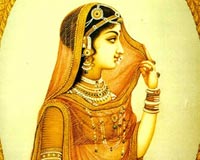 Krishna
took avatar in order to slay the demon king Kansa and to spread happiness.
During his life, Krishna met Radha and they fell in love with each other.
Krishna had a motive behind his life i.e. to kill Kansa and to fulfill this
mission; he had to face many problems. But, Radha with her intense affection
and steady devotion helped Krishna to overcome the problems. Krishna
took avatar in order to slay the demon king Kansa and to spread happiness.
During his life, Krishna met Radha and they fell in love with each other.
Krishna had a motive behind his life i.e. to kill Kansa and to fulfill this
mission; he had to face many problems. But, Radha with her intense affection
and steady devotion helped Krishna to overcome the problems.
Radha - Devotee of Krishna
Radha represents the true devotee, both in the form of male and female. And
Lord Krishna represents the divine. Intense love of Radha for Krishna
symbolizes each devotee's passionate longing for ultimate unification with
God. With her utmost devotion towards her lord, she became the supreme devotee
of Lord Krishna. Today people remember Radha-Krishna in a single term.
However, Radha was not the consort of Lord Krishna, but their love had united
them for ever. Radha is an inescapable part of Krishna. Without Radha, Krishna
doesn't mean anything and without Krishna, Radha is nothing.
Radha - The Goddess
Radha has attained the status of goddess in the Hindu Religion. Radha's
immense love and dedication towards lord Krishna got her this position, which
she truly deserves. Radha is the heavenly queen of Krishna's celestial world.
Today, Radha is worshipped like any other goddesses in temples.
Radha Gayatri Mantra
Aum Vrashbhanujaye Vidmahe
Krishnapriyaye Dheemahi
Tanno Radha Prachodayat
Radha Ashtami
Birthday of Radha is celebrated as Radhaashtami throughout the country and
especially in the north, with full devotion and joy. Radha Ashtami is observed
after 15 days of Janmashtami, which is celebrated as the birthday of Lord
Krishna. Radharani's birthday is the sacred eighth day of the month of
Bhadrapada (August-September). Sri Radha was born in Barsana, suburb of
Mathura and appeared as the daughter of Vrishabhanu and Kirti.
Celebration
On the day of Radhaashtami, devotees are allowed special sanctions which are
not allowed generally. Like, Radharani's name is usually not chanted due to
the possibility of committing faults towards her. Neither people are allowed
to enter into Radha Kunda, or Radharani's Pond, which is considered holy. On
the day of Radhastami, people wait until midnight in order to bathe there.
People chant her names on the ''appearance day'' or birthday of Sri Radha.
Radharani is believed to ''appear'', being an eternal companion of Krishna,
she does not take birth or die.
Radhastami- A Belief
Sri Radha was older to Lord Krishna and it is believed that the divine girl
did not open her eyes until Sri Krishna was born. The relationship of Sri
Krishna and Radha surpasses human concepts and is spiritual in nature. It is
redundant to affirm that one may attain Krishna only through the Grace of
Radha.
Saraswati
|
Characteristics : |
Knowledge |
|
Other Names : |
Vaagdevi, Sharda |
|
Consort : |
Lord Brahma |
|
Vehicle (Vahana) : |
Swan |
|
Mula Mantra : |
Om Aim Saraswatyai Namah |
|
Saraswati Gayatri Mantra: |
Aum Saraswatye Cha Vidmahe
Brahmaputriye Cha
Dheemahi Tanno Saraswati Prachodayat |
Goddess Saraswati is the Goddess of arts, music, knowledge, and wisdom.
Saraswati is considered as the divine consort of Lord Brahma, the Creator of
the universe. Goddess Saraswati is said to possess the powers of speech,
wisdom and learning. Saraswati is regarded as the dispeller of chaos and
confusion.
Saraswati - the Consort of Brahma
Lord Brahma is known for creating the universe. Since knowledge is required
for creation, Maa Saraswati signifies the creative power of Brahma. An apt
creation requires sound knowledge. The creation of Lord Brahma became fruitful
with the knowledge provided by Goddess Saraswati.
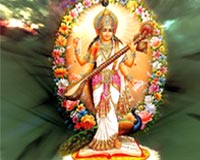 Maa
Saraswati - The Image Maa
Saraswati - The Image
Goddess Saraswati is usually depicted as a beautiful woman with yellow skin
dressed in a pure white saree. Saraswati is portrayed sitting on a white lotus
with veena (a musical instrument) in her hands. The book in her hand signifies
the eternal and universal knowledge as well her perfection of the scriptures.
Lotus symbolizes the supreme reality and it suggests that the goddess herself
is rooted in the supreme reality.
The color white represents purity and her rejection of everything that is base
and materialistic. The Swan represents the discrimination between the evil and
the good, the eternal and the transitory. The four arms of the goddess suggest
the four aspects of human personality i.e. mind, intellect, vigilance, and
ego. The pearl string represents the power of spirituality. The peacock
standing near Maa Saraswati represents arrogance and pride over its beauty.
The Goddess teaches that physical appearance could be deceptive, by not taking
peacock as the vehicle. Goddess Saraswati suggests that one should be wise
regarding the eternal truth.
Saraswati - Bestower of Knowledge
Musical instruments, books, speech, knowledge, intellect are regarded as
symbols of Saraswati. Saraswati is believed to be the provider of knowledge
that dispels ignorance and unhappiness. Saraswati is worshipped by seekers of
knowledge especially students, scholars and scientists.
Basant Panchami
Vasant Panchami marks the beginning of the spring season. The
festival of spring is celebrated with full vivacity and joy amongst the Hindu
people. In Hindi language, the word '' basant / vasant'' means ''spring'' and ''panchami''
means the fifth day. In short, Basant Panchami is celebrated as the fifth day of
Spring Season. Vasant Panchami falls on the fifth day of the Indian month, Maagh
(January-February). This festival is also known as Saraswati Puja.
Vasant Panchami and its Significance
The festival of Basant Panchami is dedicated to Saraswati, the Goddess of
Wisdom. According to the Hindu mythology, the goddess symbolizes constant flow
of knowledge and wisdom. Vasant Panchami is also believed as the birthday of
Goddess Saraswati. The spring festival of Basant Panchami is especially
celebrated in the institutions of learning. As Saraswati is the goddess of
learning, Students observe the blessings from Maa Saraswati. Spring is the
season when crops are fully bloomed, so people also celebrate this occasion by
flying kites.
Basant Panchami - Celebration
Yellow color is given special attention and dominates everywhere on this
particular day. Yellow color is associated with Goddess Saraswati as well as the
mustard crop. People wear yellow clothes, make yellow color sweets on the day of
Saraswati Puja. The Goddess of art, learning, knowledge and wisdom, Maa
Saraswati is worshipped with full dedication. On this day, People also feed
Brahmans with the feeling that their ancestors are accepting the food.
Kite-flying has become the part of this festival and people really enjoy this
event.
Basant Panchami is a festival full of religious, seasonal and social
significance. It is celebrated by Hindus all over the world with enthusiasm and
new sense of optimism.
Ganga
|
Other Names : |
Bhagirathi, Alaknanda, Dhauliganga, Padma, Mandakini |
|
Countries : |
India, Bangladesh |
|
Major cities : |
Haridwar, Kanpur, Allahabad, Varanasi, Patna |
|
Length : |
2,510 km |
|
Watershed : |
907,000 km▓ |
|
Source : |
Gaumukha, Gangotri Glacier located in Uttarakhand, India |
|
Destination : |
Ganges Delta located in Bay of Bengal, Bangladesh |
|
Major Tributaries: |
In the left, Brahmaputra, Gomti, Kosi, Gandak, Ghaghra In the right
Yamuna, Son |
Goddess Ganga
Ganga / Ganges is considered as the most sacred river of the Hindu Mythology.
River Ganges is very much popular in India and is worshipped as a goddess.
Ganga is the most revered river in the world. River Ganga is unique in itself
with its mind blowing length and width. Many other rivers of the world exceed
Ganga on these aspects but none of them can match the reverence and affection
that is shown to Ganga by the people of India and the world.
According to the Puranas (Holy Scriptures of Hindus), the sight, the name and
the touch of Ganga takes away all sins. As per Hindu thoughts, bathing in the
river on special occasions causes remission of sins and facilitates the
attainment of salvation. It is considered that Ganga bestows blessings of the
highest order. People come from far and near to immerse the ashes of their kin
in the waters of Ganga, with a belief that the ashes would go to heaven.
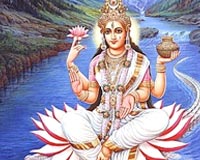 Gangajal
- The Water of Ganga Gangajal
- The Water of Ganga
Gangajal, the water of Ganga, is regarded as the most pure and sacred water on
this earth. Ganga water is used in various religious ceremonies of Hindus.
Even Science has proved that Ganga water is pure and bacteria free. Gangajal
can be kept for years without any problem.
River Ganges / Ganga
According to Hindu Mythology, Ganga is considered as the celestial creature of
heaven and it descends on the earth to rinse away the sins of the mankind. On
the earth, Ganges or Ganga originates from the Gaumukha, Gangotri glacier in
the central Himalayas, located in Uttarakhand, India. This is acknowledged as
one of the holy pilgrimages of India.
The River flows through a wide area covering several sacred places of Hindus
like Haridwar, Allahabad and Varanasi. The Ganga and its tributaries drain a
large and fertile basin with an area of about one million square kilometers
that supports one of the world's highest density human populations. After a
long journey of 2,510 kms, Ganga drains into the Bay of Bengal through its
vast delta in the Sundarbans.
Representation of River Goddess Ganga
Ganga represents the innermost pristine coolness, piety and purity. River
Ganga enriches the spiritual lives of millions and millions of Indians for
whom the river is divine. Holy River Ganga personifies Goddess Ganga who
descends to the earth to rinse away the sins of the mankind. The river Ganga
itself embodies all the characteristics India is known for: mythical, serene,
all pervading and assimilative.
Ganga Legend
Ganga, the River Goddess is the only living goddess in the Hindu pantheon.
There are numerous stories regarding the birth and origin of this goddess.
According to the beliefs, Ganga descends on the earth to rinse away the sins of
the mankind. Ganga is the sacred river and has been referred to in the various
ancient texts of Hindus. It is believed that Ganga used to flow in the heaven
and sanctify gods with her holy waters.
River Ganges is repeatedly invoked in the Puranas, the Vedas, the Ramayana and
the Mahabharata. The story of Ganga's descent on the Earth appears slightly
different in Ramayana, Mahabharata and the Puranas. According to one story,
Ganga is also considered as the sister of Parvati, the consort of Lord Shiva
being one of the two daughters of Himavat and Meru. According to another legend,
Indra had asked for Ganga to be given to heaven to calm the Gods with her cool
waters.
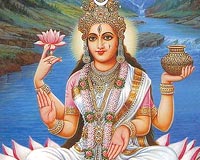 One
story states that the sacred water in Brahma's Kamandalu (water-vessel) is
personified as a maiden, Ganga. Another legend tells that Brahma had
respectfully washed the feet of Vishnu and collected this water in his Kamandalu.
Being the part of the Kamandalu of Lord Brahma, Ganga is one of the Shaktis of
the supreme Goddess Mahamaya Adishakti. One
story states that the sacred water in Brahma's Kamandalu (water-vessel) is
personified as a maiden, Ganga. Another legend tells that Brahma had
respectfully washed the feet of Vishnu and collected this water in his Kamandalu.
Being the part of the Kamandalu of Lord Brahma, Ganga is one of the Shaktis of
the supreme Goddess Mahamaya Adishakti.
Ganga Origin - Story of Bhagiratha
This is the most popular story regarding the origin of river Ganga. The story
goes far back when King Sagar magically acquired sixty thousand sons. Once, King
Sagar organized Ashwamedh Yagna, a ritual of worship for the benefit of the
kingdom. Jealous Indra planned a mischief and stole one horse from the place.
King Sagar sent all his sons all over the earth to look for the horse. They
found the horse in the nether-world standing next to Kapila Muni, a meditating
sage. The youths, were disrespectful and caused his penance to be disturbed. The
sage reduced them to ashes with his withering look.
The souls of these young men wandered as ghosts as their final rites had not
been done. On repeated repentance and requests by the descendants of King Sagar,
Kapila Muni finally relent that King Sagar's sons would attain mukti
(liberation), if their wicked remains are cleansed by the water of the goddess
Ganga. Generations of King Sagar did penance to appease Brahma but without
success and finally after much praying, pleading and tapasya by Bhagirath -
seventh generation of King Sagar, Ganga reluctantly consents to descend to
earth.
With this, Ganga found herself insulted and decided to sweep the whole earth
with her powerful fall. Troubled, Bhagiratha prayed to Shiva to control the
Ganga's descent. Lord Shiva steps in the way and trapped Ganga in his hair.
Shiva made the river fall gently through his long hair onto the Himalayas. As
Ganga moved to the nether-worlds, she liberated the unfortunate souls of King
Sagar's Sons. Since then Ganga is sanctifying the mankind with her divine
waters.
Kali
|
Characteristics : |
Destroyer, Compassionate |
|
Other Names : |
Bhadrakali, Rudrani, Dakshinakali, Aadya |
|
Abode : |
Cremation Grounds |
|
Weapon : |
Sword |
|
Mula Mantra : |
Om Kreem Kalikaye Namah |
Goddess Kali
Kali is one of the many forms of Shakti. Maha Kaali is the fiercest of all
goddesses of Hinduism. The word Kali has its roots in the Sanskrit word "Kaal",
which means time. And nothing escapes from time. Goddess Kali is sometimes
referred as the goddess of death. But actually Kali brings the death of the ego.
Even in the scriptures, she has killed demons but not anyone else. Kali is also
not associated with Yama (the Hindu God of Death). Kali is considered a form of
mother too. Maa Kali is one of the few Goddesses who are celibate and practice
renunciation.
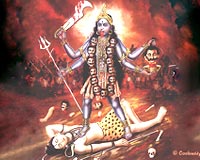 Goddess
Kali and Lord Shiva Goddess
Kali and Lord Shiva
Goddess Kali and Lord Shiva, both are regarded to inhabit cremation grounds.
Devotees go to these places to meditate with the purpose of overcoming the ego.
The cremation grounds emphasize the idea that the body is temporary. Kali and
Shiva are known to stay in cremation grounds because it is our attachment to the
body that gives rise to the ego. Kali and Shiva give the idea of liberation by
dissolving the illusion of the ego. The corporeal frame ultimately vanishes but
the soul still remains. This is emphasized by the scene in the cremation
grounds.
Maa Kali - The Compassionate Goddess
Maha Kaali is the most compassionate of all the forms of goddesses as she
provides salvation or liberation to her children. Kali is equivalent to Shiva
because both of them are the destroyers of evil fake and unreal. It is
considered that with the glimpse of Maa Kali, ego trembles with terror seeing
its own eventual demise in her.
People who are attached to their ego would not be able to receive the idea of
Kali and she will appear in a wrathful form to them. But people, who are engaged
in spirituality, removing the illusion of the ego, will find Maha Kaali in a
different form. Maa Kali will appear as sweet, affectionate, and overflowing
with perplexing love for them.
Maa Kali - The Image
Goddess Kali has four arms and hands depicting her immense strength. In two of
her hands, she holds a sword and a fresh severed head, representing a great
battle in which she defeated the demon Raktabija. The other two hands are there
to bless her true devotees, suggesting that they will be saved as she will guide
them here and in the hereafter.
Kali wears a garland made of 52 skulls and a skirt made of dismembered arms
because the ego comes out of identification with the body. It suggests that
physical body is false and spirit is the only reality. Her black or sometimes
dark blue skin represents the womb of the unmanifest from which all of creation
is born and into which all of creation will ultimately return. Therefore, the
concepts of color, light, dark, good or bad do not apply to her as she is the
pure, un-manifested energy, the Adishakti.
Goddess Kali is seen standing with her one feet on Lord Shiva who is pure
formless awareness Sat-Chit-Ananda (being-consciousness-bliss) while Kali
represents "form" eternally sustained by the underpinning of pure awareness.
Kali Aarti
Goddess Kali Arti completes the worship or prayers made to the Goddess. It is
believed that Kali aarti provides a completion to the Kali puja.
Prema Sahita Nita Karuun Aaratii
Mahaakaalii Maiyaa Ki
Ari Dala Daranii Mangala Bharanii
Dukhaharinii Sukhadaiyaa Ki
Tuma Hii Agama Bhava Bharane Waali
Tuma Hii Jagata Laya Karane Waali
Tuma Hee Kashta Lakhi Nija Bhaktana Para
Aakara Turata Sahaiyaa Ki
Tumhin Prabala Ho Hari Kii Shakti
Rudra Bhava Shankara Kii Bhakti
Tumhin Janani Patavaara Banii
Ika Sevaka Sundara Naiyaa Kii
Parvati
|
Characteristics : |
Virtuous, Fertility, Marital felicity, Asceticism, Power |
|
Other Names : |
Uma, Lalitha, Gauri, Shivakamini, Aparna |
|
Principal Scriptures : |
Lalita Sahasranama |
|
Consort : |
Lord Shiva |
|
Children : |
Lord Ganesha, Lord Kartikay (Murugana) |
|
Abode : |
Mount Kailash |
|
Vahana (Vehicle) : |
Lion |
Goddess Parvati
Parvati is a well known goddess in the Hindu mythology. Goddess Parvati is the
divine consort of Lord Shiva, the trinity god. Parvati is also considered as a
representation of Shakti or Durga, but the gentle aspect of that goddess not the
fierce one. Maa Parvati is beautifully presented in the Hindu Literature as
being beautiful, as a mediator in the conflicts of heaven, as a daughter of the
Great Himalayan Mountains and as the divine sister of Goddess Ganga.
The divine motherly love of Parvati is visible with her two children Ganpati and
Kartikay. According to the Hindu Belief, Parvati is the second consort of Shiva,
the Hindu God of destruction and rejuvenation. Although, she is not different
from Dakshayani (Sati), being the reincarnation of that former consort of Lord
Shiva.
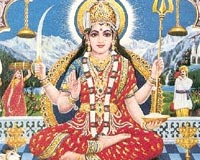 Parvati
- Form of Shakti Parvati
- Form of Shakti
Parvati is believed to be one of the many forms of "Shakti". People take her to
be the divine sister of Maa Kali, Maa Lakshmi, Maa Saraswati, Durga and all
other forms of Shakti. Durga (Goddess beyond reach) and Kali (Goddess of
Destruction) are the two fierce but very powerful forms of Parvati.
Goddess Parvati - Other Names
The word Parvati has been derived from a Sanskrit word "Parvat" meaning
mountain. So, "Parvati" means "she of the mountains" and suggests that Parvati
is the daughter of Himavat (the personification of the Himalayas) and the apsara
(fairy) Mena. Lalita, Uma, Gauri, Kali, Durga, Haimavati etc are the other names
for Parvati. Amba is the other name of Parvati being the mother of the universe
and Ambika, being the 'mother'. As Lalita, she represents the aspect of beauty
and magnificence. Lalita Saharanama contains a thousand of her names.
Parvati - Her Symbolism
Goddess Parvati symbolizes noble virtues admired by the Hindu religion. Parvati
is the better half of Lord Shiva, the most innocent and the fiercest god in
Hindu tradition. The couple together symbolizes both power of renunciation and
asceticism and the blessings of marital felicity. There are legends behind the
marriage of lord Shiva and Parvati, being a devotee of Shiv-Shambhu. Parvati did
a lot of tap in order to get Shiva as her soul mate. Parvati's dedication was
really true which made Lord Shiva to marry her.
Fertility, marital felicity, devotion to the spouse, asceticism and power are
different virtues symbolized by Parvati. These virtues are highly valued by the
Hindu tradition. As per a famous literary work on the goddess, Saundarya Lahiri,
Parvati is the source of all the power in this universe and Lord Shiva gets all
his powers from her.
Sita
|
Characteristics : |
Ideal woman, Virtuous |
|
Other Names : |
Janaki, Maithili, Ramaa, Vaidehi |
|
Principal Scriptures : |
The Ramayana |
|
Consort : |
Lord Rama |
|
Sita Gayatri Mantra : |
Aum Janaknandiniye Vidmahe
Bhumijayai Dheemahi
Tanno Sita Prachodayat |
Goddess Sita Maa
Sita is the consort of Lord Rama, the seventh avatar (incarnation) of Lord
Vishnu. Sita is the one of the most popular goddesses of Hindu religion. Devi
Sita is regarded as the incarnation of Goddess Lakshmi, the divine consort of
Lord Vishnu. Sita is considered as the ideal daughter, ideal wife, and ideal
mother, since ages. Goddess Sita is remembered for her virtues and attributes.
Devi Sita symbolizes all that is noble in womanhood.
Devi Sita - A Woman of Virtue
Sita is one of the principal characters in The Ramayana, the great epic of
India. Her entire life constitutes an example of idealism. Sita is a perfect
example of loyalty and morality. Goddess Sita leaves the palace charms and
amenities, in order to stay in exile with her husband. During the period of
exile, Sita was abducted by the demon-king Ravana and imprisoned for months, in
Lanka. When Sita got freed from the clutches of Ravana, she proved her sanctity
to Lord Rama by giving Agni - Pariksha (Fire Ordeal). Sita is regarded as the
role model of wifely love and adherence to duty.
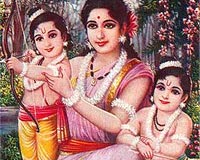 Maa
Sita - Mother of Luv - Kush Maa
Sita - Mother of Luv - Kush
After returning from the exile, Ram and Sita were declared as the king and the
queen of Ayodhaya, respectively. Sita's imprisonment in lanka became a
consideration for the people of Ayodhaya. Lord Rama loved his wife endearly, but
with no other option left, he banished Sita from his household. Sita again found
herself in exile, this time she was not only alone but also pregnant. Sita got
refuge in the hermitage of sage Valmiki, where she delivered twins, and named
them Luv and Kush. She brought up her sons single handedly in the hermitage.
Sita is a brave woman of extraordinary brilliance. She has got all the values
that people believe, a woman must have in her character. Sita is a woman of
virtue and of immeasurable patience. Through her great character, she has
captured hearts of millions of people.
|


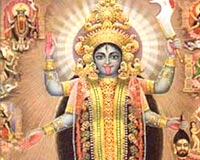
 Goddess
Durga (Mother)
Goddess
Durga (Mother)  Origin
of Goddess
Origin
of Goddess Lakshmi
and her association with "Shri''
Lakshmi
and her association with "Shri'' 
 Krishna
took avatar in order to slay the demon king Kansa and to spread happiness.
During his life, Krishna met Radha and they fell in love with each other.
Krishna had a motive behind his life i.e. to kill Kansa and to fulfill this
mission; he had to face many problems. But, Radha with her intense affection
and steady devotion helped Krishna to overcome the problems.
Krishna
took avatar in order to slay the demon king Kansa and to spread happiness.
During his life, Krishna met Radha and they fell in love with each other.
Krishna had a motive behind his life i.e. to kill Kansa and to fulfill this
mission; he had to face many problems. But, Radha with her intense affection
and steady devotion helped Krishna to overcome the problems.  Maa
Saraswati - The Image
Maa
Saraswati - The Image Gangajal
- The Water of Ganga
Gangajal
- The Water of Ganga One
story states that the sacred water in Brahma's Kamandalu (water-vessel) is
personified as a maiden, Ganga. Another legend tells that Brahma had
respectfully washed the feet of Vishnu and collected this water in his Kamandalu.
Being the part of the Kamandalu of Lord Brahma, Ganga is one of the Shaktis of
the supreme Goddess Mahamaya Adishakti.
One
story states that the sacred water in Brahma's Kamandalu (water-vessel) is
personified as a maiden, Ganga. Another legend tells that Brahma had
respectfully washed the feet of Vishnu and collected this water in his Kamandalu.
Being the part of the Kamandalu of Lord Brahma, Ganga is one of the Shaktis of
the supreme Goddess Mahamaya Adishakti. Goddess
Kali and Lord Shiva
Goddess
Kali and Lord Shiva Parvati
- Form of Shakti
Parvati
- Form of Shakti  Maa
Sita - Mother of Luv - Kush
Maa
Sita - Mother of Luv - Kush